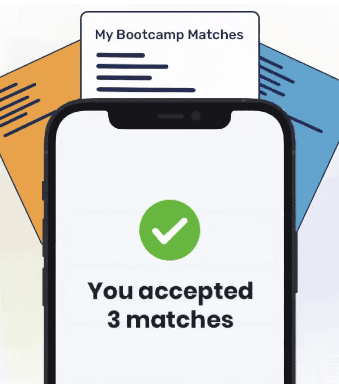Trying to determine the pros and cons of deferred tuition vs income share agreement? Wondering about coding bootcamp ISAs in general? Well, you have come to the right place. Here at Career Karma, we have researched all of your coding bootcamp payment options and compiled all the information you need into this handy guide.
Everything you have ever wanted to know about financing a bootcamp education, deferred tuition plans, coding bootcamp ISAs, and which bootcamps offer the best income share agreement programs is all right here.
What Are Income Share Agreements?
A coding bootcamp income share agreement (ISA) is an arrangement with the bootcamp where a percentage of your future income after graduation will be paid to the coding bootcamp for a fixed period of time.
The specific terms of these income share agreements for coding bootcamps can vary. But usually the salary range percentage a coding bootcamp enrollee will agree to pay somewhere between eight percent and 25 percent over a period of one to four years.
Coding Bootcamp ISA Facts
- ISA: when you pay a portion of your future salary back to your coding bootcamp in order to fund your education with them.
- How much do you pay back? Generally eight percent to 25 percent of your salary.
- For how long? Anywhere between one to four years is typical.
- Many consider ISAs to be a type of coding bootcamp job guarantee.
How to Finance a Bootcamp Education

There are quite a few avenues you can explore to fund your bootcamp training. While we will primarily focus on the ins and outs of coding bootcamp ISAs in this guide, here are the most common methods you can use outside of an ISA:
Upfront Payment
An upfront payment is typically the most straightforward payment method. With this payment option, all you do is pay the entire cost of your tuition upfront. This method of payment helps you avoid various fees and interest charges. However, it can be difficult for most people to come up with such a large amount of cash, so this option is not always feasible.
Monthly Payments
Getting on a monthly payment plan is quite popular for eligible students. This allows you to reach an agreement with your coding bootcamp and settle on a payment plan made up of predetermined monthly installments. Sometimes, these plans will accrue interest fees, but not often. Most will require you to make a significant down payment prior to starting the program.
Deferred Tuition Plan
A deferred tuition plan is a financial agreement that allows students to start making monthly payments only after graduation. Like an ISA, tuition is not paid back until after you graduate. However, unlike an income share agreement, this method of payment does not take your job status and salary into consideration. You would be required to make these monthly payments, as well as a deposit upfront, regardless of your employment status.
Personal Loans
Similar to how college students take out student loans, bootcamp students can take out a private loan to fund their education. While the idea of a personal loan may seem intimidating, especially with all the talk about student loan debt lately, this is actually one of the most common methods of payment at coding bootcamps.
Many bootcamps even partner with low-interest loan providers, such as Climb Credit and Ascent Funding, previously known as Skills Fund. This makes it easier for students to pay back the entire loan.
GI Bill
The GI Bill is not accepted at all coding bootcamps, but more and more are able to accept its educational benefits every week. This is a great option for veterans and their dependent children or spouses to pursue an education and tech job. Many GI Bill users not only have the entire cost of their tuition covered but receive a substantial monthly living stipend as well.
Scholarships
Most coding bootcamps offer various scholarships. While some of the scholarships are available to everyone, many are tailored to specific groups of people. This means that if you are a woman, LGBTQ+ person, person of color, or anyone else considered part of a group that is underrepresented in tech, you are likely to find a plethora of scholarship opportunities.
Deferred Tuition vs ISA: What’s the Difference?
Both deferred tuition and ISA plans present great options for those looking for ways to pay for coding bootcamp, but there are differences between the two options. Basically, while ISAs operate on the agreement of paying back your coding bootcamp in percentages (i.e. [x]% of your future salary for [y] years), deferred payments operate on fixed, predetermined payments that don’t leverage percentages.
Here are some examples of what these differences could actually look like. Please note these examples aren’t factoring in interest, which can increase the actual cost.
Example of Deferred Tuition Program for $17,500 Course
- In this deferred tuition example, let’s say one pays $3,000 upfront, which leaves $14,500 left. The program can stipulate that the remaining payment of $14,500 can be paid back in fixed amounts (not percentages) over a period of time. So that may potentially look like 12 payments of $1,208 over the course of a year or 24 payments of $604 over the course of two years.
Example of Income Share Agreement with $17,500 Cap
- In this coding bootcamp ISA example, one doesn’t pay anything upfront and the maximum you would pay is $17,500. Let’s say that the ISA is 17% of one’s salary over 3 years (once a job is found) with a repayment cap of $17,500. At a yearly salary of $65,000, 17% would be $8,450 over the course of one year. With $8,450 in year 2 and $600 in year 3. At 17% over three years the payments would ultimately add up to $17,500. When it comes down to ISA vs student loan vs deferred tuition, ISA is more affordable upfront.
Advantages of Income Share Agreements
The reality is that coding bootcamps ISAs present a great opportunity for those who want to learn coding but can’t afford the education on their current income. It also creates accountability on the side of the coding bootcamp, which basically ensures that the goals of students are aligned with those of the coding bootcamp (the goal being to land strong job placement post-graduation).
This is in contrast to more traditional avenues of financing education which usually entail a direct loan where payments are typically expected after course completion and not upon job placement.
The other advantage of income share agreements is that as a learner in a coding bootcamp, you usually don’t have to worry about any upfront tuition costs besides the nominal deposit to hold your seat. This is a huge relief and just allows you to focus on what’s truly important during the program – learning!
On the same spectrum income share agreements are also great because if you want to enroll in a coding bootcamp to improve your career prospects, you don’t have to have thousands and thousands of dollars saved up in order to be eligible to enroll. The pool of applicable candidates is much more open when you go the route of ISAs.
Disadvantages of Income Share Agreements
One of the main criticisms of coding bootcamp ISAs is the framework being built up on salary percentage paybacks. For example, let’s say you’re earning approximately $35,000 before coding bootcamp. Then after you leverage an ISA to enroll and complete the course, you land a job with a salary of $70,000.
That’s awesome, but that ISA you agreed to featured a percentage payback of 15% of your salary. That works out to $10,500 over the course of however many years the agreement is. While you’re still making more than you had previously made before the bootcamp, a significant percentage of your salary goes back to the coding bootcamp you completed. Sometimes, the portion you pay back exceeds the normal cost of that bootcamps tuition.
Obviously weighing the pros and cons of this feature is contingent upon each individual to determine whether or not an ISA is the proper course of action for them. Some people decide it’s worth it in order to improve their overall careers and some people pursue other options that may be available (like deferred payments).
What if I Use a Coding Bootcamp ISA and Can’t Find a Job Post-Graduation?

This is a common question and one that is honestly very smart to ponder when you’re considering using an income share agreement to pay for your coding bootcamp. Some schools that offer deferred tuition and ISA plans do actually offer a grace period. These are usually around three months for successful coding bootcamp graduates to find a job.
This can alleviate some of the stress of not finding a job after graduation, but whether or not that 3 months is enough is really determined by how each individual coding bootcamp graduate hunts for that new job.
To accommodate a wider range of students hunting for new jobs after coding bootcamp, some schools also even allow a grace period of up to one year. There are even some schools that have extra added accommodations for coding bootcamp graduates that don’t require payments to start unless that individual has found a job paying more than $40,000 within eight years of graduating.
What Should I Know About Coding Bootcamp ISAs?
The reality of any type of repayment agreement is that you really need to hone in on the fine print. Read everything thoroughly and understand the terms you are agreeing to when you sign into an employer sponsorship with your coding bootcamp. That way when you complete your program, find that awesome new job, and the payments start to kick in, you aren’t surprised by unexpected details.
In addition to reading the items yourself, you can leverage your resources at the coding bootcamp for understanding the terms of the income share agreement plan. Set up appoints to speak with the financial facilitators or whoever the stakeholders are for managing ISAs.
Here are some questions that you may find helpful when evaluating an income share agreement with the coding bootcamp’s representative.

"Career Karma entered my life when I needed it most and quickly helped me match with a bootcamp. Two months after graduating, I found my dream job that aligned with my values and goals in life!"
Venus, Software Engineer at Rockbot
1) Do you have to accept the first job that you’re offered?
- Some programs structure this clause into their agreements. Understanding how this may impact your own personal goals for coding bootcamp enrollment is paramount in order to determine if an ISA is right for you. Speak with an advisor to determine what the requirement is for your school.
2) Does the coding bootcamp ISA have a minimum salary requirement?
- This is a question to consider in regards to understanding the possible disadvantages of ISAs. Some ISA programs require you to pay a higher percentage if you salary is on the lower end of the spectrum. The numbers are generally specific to each program so please be sure to ask for details on this when you reach out.
3) Are there any payments caps or restrictions on paying back within the income share agreement?
- It’s paramount to have an understanding of how long the term is going to be for your salary percentage payments and what those caps are. In some instances, if there are no caps, it is possible to end up being locked into an ISA where you end up paying more than you would have over a period of time as compared to a traditional loan.
4) What does the coding bootcamp ISA stipulate if you cannot find a job within the allotted time frame?
- Are you protected in these instances? Will you still have to make payments even if you don’t have a new job? These are important questions to ask your advisor when enrolling in any bootcamp program. The answers will vary depending on the school, but many do not require any tuition payments if you cannot find a qualifying job.
5) When comparing all coding bootcamp tuition payment types, which is the least expensive?
- Sometimes not all the costs or fees are understood when evaluating different coding bootcamp financing options. Get an understanding of how each item works, put it all out in front of you, and weigh the actual end-of-the-day costs to see the true total cost of each option available.
Qualifying: How to Get a Coding Bootcamp ISA
ISAs are still a form of financial aid, which means that there are eligibility requirements to be met in order to fund your coding bootcamp. ISA eligibility varies from institution to institution however there are some commonalities that one can expect.
Credit Score
- This can be an indicator to the ISA-issuing institution of whether or not you have a history of presenting a potential financial risk to a lending party. If a school is going to invest money in your education for the goal of having the terms of the ISA fulfilled, a good Credit Score is important. Depending on the school, some bootcamp will accept students with bad or no credit history.
Employment History
- Since employment after the coding bootcamp is a key facet of an ISA, employment history can impact eligibility. For example, if one has an employment history that features gaps or many short-term periods of employment, an ISA-issuer may take notice.
Since eligibility requirements must be met, it’s possible for some candidates to not qualify for an Income Share Agreement plan. Please review the requirements to qualify with each specific institution you’re applying to in order to ensure you’re able to fund your coding bootcamp experience.
Coding Bootcamps and Schools with Income Share Agreements
Coding bootcamps all over the country, from San Francisco to New York City, offer income share agreements as a payment structure. While some of these schools, like Holberton School, App Academy, and Lambda School (BloomTech) have higher repayment caps, these are still some of the best coding bootcamp ISAs out there.
Here are the top 10 programs that offer ISAs as one of the tuition options for students.
| Coding Bootcamp | ISA Payment Cap | Minimum Salary Requirement |
|---|---|---|
| Thinkful | Varies by program | $40,000 per year |
| General Assembly | 1.5x tuition | $40,000 per year |
| Flatiron School | 1.5x tuition | $40,000 per year |
| Holberton School | $85,000 | No minimum salary requirement |
| Lambda School (now BloomTech) | $37,950 or $42,950 | $50,000 per year |
| App Academy | $31,000 | $50,000 per year |
| CodeX Academy | Speak with advisor for info | Speak with advisor for info |
| Microverse | $15,000 | $1,000 per month |
| Hackbright Academy | 1.4x amount financed | $50,000 per year |
| Rithm School | $34,500 | $60,000 per year |
1) Thinkful
- Locations: Online, nationwide in over 20 cities
- Program types: In-person, remote, full-time, part-time, self-paced
- Payment methods: Upfront, monthly installments, deferred tuition, deferred tuition with a living stipend, ISA, ISA with living stipend
Thinkful has designed its programs to cater to the preparation of those who want to enter software engineering roles (and who are looking for a salary increase). That’s why their coding bootcamp offers programs in full stack web development, data science, data analytics, and product design. The ISA offered by this school is an excellent alternative to afford the Thinkful cost.
Thinkful ISA Details
The Thinkful ISA requires graduates to first accept a job that pays at least $40,000 per year. Then, students will pay 15 percent of their salary to Thinkful each year for up to two years, or until they reach the payment cap set forth by the specific program attended.
2) General Assembly
- Locations: Online, 10 US cities, international offices in Asia, Australia, and Europe
- Program types: In-person, remote, full-time immersive, part-time evenings, flex immersive program, self-paced
- Payment methods: Upfront, monthly installments, ISAs, personal loans, GI Bill
Available income share agreement eligible programs within General Assembly include code training, data science, and design. The ultimate goal of General Assembly is to help everyone around the world gain the skills they need to have the career they want while also ensuring that global companies are getting the highly trained workforce that they need to grow.
General Assembly ISA Details
The General Assembly ISA requires you to first make a deposit of $250 toward your General Assembly cost. Then, after you graduate, you have to find a job earning at least $40,000 per year. Once you are employed, you will pay General Assembly 10 percent of your annual salary for up to four years, or until you have reached the payment cap of 1.5 times the program tuition.
3) Flatiron School
- Locations: Online, Denver, Colorado Springs, New York City
- Program types: In-person, remote, full-time, part-time
- Payment methods: Upfront, personal loans, monthly payments, ISAs, scholarships
Income share agreements can be used to cover the Flatiron School costs for its software engineering, data science, and UX/UI design coding bootcamp programs. Even though Flatiron School is available in multiple locations, ISA eligibility is only an option for those in Atlanta.
Flatiron School ISA Details
The Flatiron School income share agreement requires students to pay an upfront deposit of $2,850 toward the program. After graduating, you must have a minimum income threshold of $40,000 per year or a monthly income that is equivalent.
Once you meet the minimum income threshold, you have up to six months after graduating to begin paying 10 percent of your annual earnings to Flatiron School. You will pay until you reach the repayment cap of 1.5 times the cost of tuition.
4) Holberton School
- Locations: New Haven, Tulsa, over 20 international cities
- Program types: In-person, full-time intensive
- Payment methods: Upfront, personal loans, ISA, scholarships, living stipend
Holberton School specializes in training full stack engineers. Its coding bootcamps are structured on 100 percent hands-on learning and the curriculum leverages peer learning and project-based pedagogy. This school also offers flexible tuition payment methods, including the option to apply for a monthly stipend to help cover living costs while you study.
Holberton School ISA Details
The Holberton School ISA allows students to attend the program at no cost. This means no upfront payment is necessary, eliminating a common barrier to entry for many. Once you graduate from Holberton School, you will be able to use the school’s career coaches to find a job.
Holberton School boasts one of the best coding bootcamp ISAs in terms of interest: there is none. You will simply pay 17 percent of your salary for 42 months or until you have paid back the $85,000 tuition, whichever comes first.
5) Lambda School (now Bloomtech)
- Locations: Online
- Program types: Remote, full-time
- Payment methods: Upfront, outcomes-based loan, ISA, scholarships
Developed on a 9am to 6pm six-month program, Bloomtech (formerly known as Lambda School) offers a fully online coding bootcamps to all those who are eligible. Program focuses include computer science concepts, C++, and Javascript. Please note that the online course is only available to USA or EU/UK residents.
Bloomtech ISA Details
At Bloomtech students can avoid the entire upfront tuition cost and enroll in an ISA. There are two options for a Bloomtech ISA. The first requires a $7,950 deposit, and you will make up to 36 monthly payments, with a cap of $37,950. The other Bloomtech ISA requires a $2,950 deposit, and you will make up to 48 monthly payments with a cap of $42,950.
Once you graduate, you will have the opportunity to work with career coaches to find a well-paying job. After finding a qualifying job, you will pay 14 percent of your income until you have reached your agreed-upon payment cap or reached a certain number of monthly payments.
6) App Academy
- Locations: San Francisco, New York City, online
- Program types: Remote, in-person, full-time, part-time
- Payment methods: Upfront, deferred tuition/ISA, hybrid
App Academy offers a bootcamp experience designed to prepare you for a career switch into software engineering. This program is offered in person as a full-time program, or online either full-time or part-time. You will focus on learning the most in-demand coding languages and career skills for tech talent at the time of your enrollment.
App Academy ISA Details
The App Academy ISA offers students a chance to avoid paying any tuition upfront. Once you are nearing graduation, App Academy will set you up with its career services, where you will have access to career coaching. This allows students to have an easier time with their career search and find a job in a fast-growing career.
App Academy considers a qualifying job to be one in which you earn $50,000 per year or more. You’ll begin making monthly payments equal to 15 percent of your monthly income, before taxes. This continues for 36 months or until you reach the payment cap of $31,000.
7) CodeX Academy
- Locations: Online
- Program types: Remote, self-paced
- Payment methods: Deferred tuition, ISA
At CodeX Academy, you can choose between a full stack development, front end development, or full stack engineering program. Each program can be completed completely online, at your own pace. CodeX Academy offers live one-on-one mentorship for all students, as well as a guaranteed internship after graduating.
CodeX Academy ISA Details
CodeX Academy, unfortunately, has not released many details of its coding bootcamp ISA to the public. Each income share agreement at this school is tailored to the student, so you will have to speak with an advisor for more details. However, the school does boast a guarantee of zero payments until you find a qualifying job. Once you do find a high-paying job, expect to pay only 10 percent of your salary.
8) Microverse
- Locations: Online
- Program types: Remote, full-time
- Payment methods: ISA
Microverse has created its curriculum to function as a full-time online bootcamp that takes place over 22 weeks. The program is designed to develop a student’s skills in key software development facets like front end Javascript, backend Ruby on Rails, data structures, and more.
Microverse ISA Details
The ISA at Microverse does not require any sort of upfront payment, which allows students to focus on studying so that they can find a decent job upon graduating. Once you find a part-time or full-time job that pays at least $1,000 per month, you’ll begin paying back your tuition fees. The job must be in a software-related field. You’ll pay Microverse 15 percent of your income until you have fully paid back the $15,000 in tuition.
9) Hackbright Academy
- Locations: Online, San Francisco, Dallas, Lehi
- Program types: In-person, remote, full-time, part-time
- Payment methods: Personal loans, ISA, scholarships
Hackbright Academy is a coding bootcamp specifically for women as well as female-identifying and gender non-binary people. It was designed to help close the gender gap in the tech industry.
This school offers a full-time and part-time software engineering program. Typically, it is offered both in-person and online, but due to COVID-19, the program is only offered remotely for the time being.
Hackbright Academy ISA Details
At Hackbright Academy, you can enroll in an ISA through Stride Funding. The details vary based on your eligibility, but there are a few constants. Students will never pay more than 1.4 times the amount borrowed, and you can only borrow up to $12,650. There are options for 36 or 72 monthly installments.
You will only pay up to nine percent of your monthly income, with interest of up to 21 percent. Finally, payments within the Hackbright Academy’s ISA plan change based on graduates’ monthly income. If you do not earn at least $4,166 each month, your payments will be deferred until you are earning that much.
10) Rithm School
- Location: Online, San Francisco
- Program types: In-person, remote, full-time
- Payment methods: Upfront, personal loans, deferred tuition/ISA, hybrid
Candidates in the Rithm School are full-time learners who will receive development skills training in back and front end engineering. Rithm School is focused on immersive, hands-on learning and is known for its low student-to-teacher ratio.
Rithm School ISA Details
The Rithm School ISA is also referred to as its deferred tuition payment method. If you choose the ISA plan, there is no upfront tuition cost. Instead, once you graduate, you will have to find a job that pays at least $60,000 per year. Then, you will pay 17 percent of your annual income to Rithm School for two years or until you reach the repayment cap of $34,500.
Should I Enter a Coding Bootcamp ISA?
Overall, there are many ISAs offered by various coding bootcamps. While it is a big commitment to make, many students find great success in utilizing an ISA payment plan. Be sure to chat with your advisor before making the decision to sign one.
Get Additional Guidance from Career Karma
Coding Bootcamp ISA FAQ
A coding bootcamp is definitely worth it in 2022. More and more employers are preferring candidates with bootcamp training over a college degree. A bootcamp education with a flexible payment schedule is ideal for most students. While coding bootcamps that offer ISAs are great choices, some that don’t, like Fullstack Academy, are also fantastic options.
Sometimes coding bootcamp tuition is tax-deductible, but it depends on your reason for enrolling. Essentially, the IRS will consider your bootcamp tuition tax-deductible if you are enrolling to maintain your current career and prevent your skills from becoming outdated, even if the training is not required by your employer.
Employers do like coding bootcamps and will accept candidates who have completed both full-time and part-time programs. While some employers still see a degree program as the way to go, most recognize coding bootcamps as equal, and even superior, forms of tech education.
Yes, programming is a good career. You can find many different jobs from full stack web development to digital marketing to cyber security within the programming job field. Most programmers report high salaries, high job satisfaction, and great career benefits.
About us: Career Karma is a platform designed to help job seekers find, research, and connect with job training programs to advance their careers. Learn about the CK publication.


